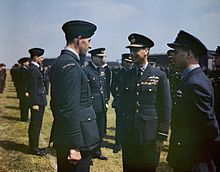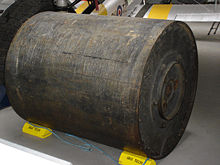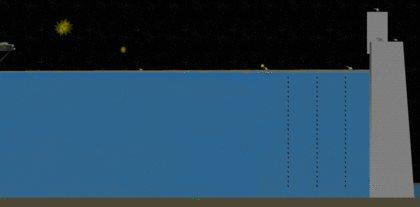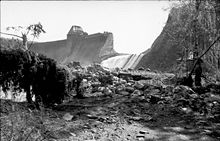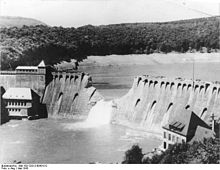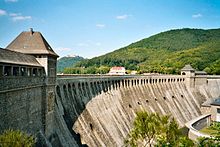- Operation Chastise
-
Operation Chastise Part of the Second World War 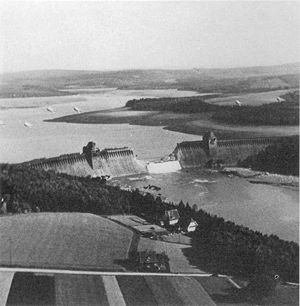
The Möhne dam on the day following the attacks.Date 16–17 May 1943 Location Eder, Möhne and Sorpe (Röhr) rivers, Germany Result Limited British success Belligerents  United Kingdom
United Kingdom Nazi Germany
Nazi GermanyCommanders and leaders  Guy Gibson
Guy Gibson Josef Kammhuber
Josef KammhuberStrength 19 Lancaster bombers XII. Fliegerkorps
(Defending three dams)Casualties and losses 8 aircraft shot down,
53 aircrew killed,
3 aircrew taken prisoner.2 dams breached,
1 dam lightly damaged,
approx. 1,600 killed
(including 1,000+ prisoners and forced labourers).Operation Chastise was an attack on German dams carried out on 16–17 May 1943 by Royal Air Force No. 617 Squadron, subsequently known as the "Dambusters", using a specially developed "bouncing bomb" invented and developed by Barnes Wallis. The Möhne and Edersee Dams were breached, causing catastrophic flooding of the Ruhr valley and of villages in the Eder valley, while the Sorpe dam sustained only minor damage.
Contents
Background
Prior to World War II, the British Air Ministry had identified Germany's heavily industrialised Ruhr Valley, and especially its dams, as important strategic targets: in addition to providing hydro-electric power they also supplied drinking water and water for the canal transport system. The methods used to attack the dams had been carefully worked out. Calculations indicated that repeated air strikes with large bombs could be effective, but required a degree of accuracy which Bomber Command had been unable to attain in the face of enemy defences.
Concept
The mission grew out of a concept for a bomb designed by Barnes Wallis and developed by his team at Vickers. Wallis was an aircraft designer who had worked on both the Vickers Wellesley and Vickers Wellington bombers. While working on aircraft he had also begun work on a bomb designed specifically with dam-destruction in mind.
Wallis' initial idea was to drop a 10 t (9.8 long tons; 11 short tons) bomb from an altitude of about 40,000 ft (12,200 m). This idea was part of the earthquake bomb concept. However, at that time no bomber aircraft was capable of flying at that altitude with such a heavy payload.
A much smaller explosive charge would suffice, if it could be exploded directly against the dam wall below the surface of the water, but the major German reservoir dams were protected by heavy torpedo nets to prevent such an attack.
 Air Vice-Marshal Ralph Cochrane, Wing Commander Guy Gibson, King George VI and Group Captain John Whitworth discussing the Dambuster Raid in May 1943.
Air Vice-Marshal Ralph Cochrane, Wing Commander Guy Gibson, King George VI and Group Captain John Whitworth discussing the Dambuster Raid in May 1943.
Wallis' breakthrough overcame this. A drum-shaped bomb spinning backwards at over 500 rpm, dropped at a sufficiently low altitude at the correct speed, would skip for a significant distance over the surface of the water in a series of bounces before reaching the dam wall. Its residual spin would run the bomb down the side of the dam to its underwater base. Using a hydrostatic fuse, an accurate drop could bypass the dam's defences and enable the bomb to explode against the dam.
Testing included blowing up a plaster model dam at the Building Research Establishment, Watford, and the breaching of the disused Nant-y-Gro dam in Wales.
Development of Wallis' weapon was given final approval on 26 February 1943. The bomb was codenamed "Upkeep", and a target date was set for May, when water levels would be at their highest and breaches in the dams would cause the most damage.
Assignment
The operation was given to No. 5 Group RAF which formed a new squadron to undertake the dams mission. It was initially called Squadron "X", as the speed of its formation outstripped the RAF process for naming squadrons.
Led by Wing Commander Guy Gibson, a veteran of over 170 bombing and night-fighter missions, 21 bomber crews were hand-picked from existing squadrons in 5 Group. These crews included RAF personnel of several different nationalities, as well as members of the Royal Australian Air Force (RAAF), Royal Canadian Air Force (RCAF) and Royal New Zealand Air Force (RNZAF), who were frequently attached to RAF squadrons under the British Commonwealth Air Training Plan. The squadron was based at RAF Scampton, about 5 mi (8 km) north of Lincoln.
The targets selected were the two key dams upstream from the Ruhr industrial area, the Möhne Dam and the Sorpe Dam, with the Eder Dam on the Eder River, which feeds into the Weser, as a secondary target. While the loss of hydroelectric power was important, the loss of water supply to industry, cities, and canals would have greater effect. Also, there was the potential for devastating flooding if the dams broke.
The aircraft were modified Avro Lancaster Mk IIIs, known as B Mark III Special (Type 464 Provisioning).[1] To reduce weight, much of the internal armour was removed, as was the mid-upper machine gun turret. The size of the bomb with its unusual shape meant that the bomb-bay doors had to be removed, and the bomb itself hung, in part, below the fuselage of the aircraft. It was mounted on two crutches, and before dropping it was spun up to speed by an auxiliary motor.[2]
Preparations
Bombing from an altitude of 60 ft (18 m), at an air speed of 240 mph (390 km/h), and at a pre-selected distance from the target called for expert crews. Intensive night-time and low-altitude flight training began.
There were also technical problems to solve, the first one being to determine when the aircraft was at optimum distance from its target. Both the Möhne and Eder Dams had towers at each end. A special targeting device with two prongs, making the same angle as the two towers at the correct distance from the dam, showed when to release the bomb. (The BBC documentary Dambusters Declassified (2010) stated that the pronged device was not used due to issues related to vibration and that other methods were employed, including a length of string tied in a loop and pulled back centrally to a fixed point in the manner of a catapult.)
The second problem was determining the aircraft's altitude, as the barometric altimeters then in use lacked sufficient accuracy. Two spotlights were mounted, one under the aircraft's nose and the other under the fuselage, so that at the correct height their light beams would converge on the surface of the water. The crews practised at the Eyebrook Reservoir, in Leicestershire/Rutland, Abberton Reservoir near Colchester, Derwent Reservoir, and Fleet Lagoon on Chesil Beach. Wallis' bomb itself was first tested at the Elan Valley Reservoirs.
The bombs were delivered to the squadron on 13 May, after the final tests on 29 April. At 1800 on 15 May, at a meeting in Whitworth's house, Gibson and Wallis briefed four key officers: the squadron's two flight commanders, Squadron Leader Henry Maudslay and Sqn Ldr H. M. "Dinghy" Young; Gibson's deputy for the Möhne attack, Fl.Lt. John V.Hopgood and; the squadron bombing leader, Flight Lieutenant Bob Hay. The rest of the crews were told at a series of briefings the following day, which began with a briefing of pilots, navigators and bomb aimers at about midday.
Organisation
The squadron was divided into three groups.
Formation No. 1 was composed of nine aircraft in three groups: (listed by pilot) Gibson, Hopgood and Flt Lt H. B. "Micky" Martin (an Australian serving in the RAF); Young, Flt Lt David Maltby and Flt Lt Dave Shannon (RAAF), and; Maudslay, Flt Lt Bill Astell and Flying Officer Les Knight (RAAF). Its mission was to attack the Möhne; any aircraft with bombs remaining would then attack the Eder.
Formation No. 2, numbering five aircraft, piloted by Flt Lt Joe McCarthy (an American serving in the RCAF), Pilot Officer Vernon Byers, Flt Lt Bob Barlow (RAAF), P/O Geoff Rice and Flt Lt Les Munro (RNZAF), was to attack the Sorpe.
Formation No. 3 was a mobile reserve consisting of aircraft piloted by Flight Sergeant Cyril Anderson, Flt Sgt Bill Townsend, Flt Sgt Ken Brown (RCAF), P/O Warner Ottley and P/O Lewis Burpee (RCAF), taking off two hours later on 17 May, either to bomb the main dams or smaller secondary target dams at Schwelm, Ennepe and Diemel.
Two crews were unable to make the mission due to illness.
The Operations Room for the mission was at 5 Group Headquarters in St Vincents Hall Grantham, Lincolnshire. The mission codes (transmitted in morse) were: Goner, meaning "bomb dropped"; Nigger, meaning that the Möhne was breached and; Dinghy meaning that the Eder was breached. "Nigger" was the name of Gibson's dog, a black labrador retriever that had been run over and killed on the morning of the attack.[3] "Dinghy" was Young's nickname, a reference to the fact that he had made many forced landings at sea, requiring him to use the rubber dinghies stowed on RAF aircraft.
The bombing raids
Outbound
The aircraft used two routes, carefully avoiding known concentrations of German anti-aircraft flak, and were timed to cross the enemy coast simultaneously. The first aircraft, those of Formation No. 2 and heading for the longer, northern route, took off at 21:28.[4] McCarthy's bomber had a hydraulics problem, and he took off in a reserve craft 20 minutes late.
Formation No. 1 took off in groups of three at 10 minute intervals beginning at 21:39.[4] The reserve formation did not begin taking off until 00:09 on 17 May.[4]
Formation No. 1 entered continental Europe between Walcheren and Schouwen, flew over the Netherlands, skirted the airbases at Gilze-Rijen and Eindhoven, curved around the Ruhr defences, and turned north to avoid Hamm before turning south to head for the Möhne River. Formation No. 2 flew further north, cutting over Vlieland and crossing the IJsselmeer before joining the first route near Wesel and then flying south beyond the Möhne to the Sorpe River.
The bombers flew low, at about 100 ft (30 m) altitude, to avoid radar detection. Flight Sergeant George Chalmers, radio operator on "O for Orange", looked out through the astrodome and was astonished to see that his pilot was flying towards the target along a forest's firebreak, below treetop level.
First casualties
The first casualties were suffered soon after reaching the Dutch coast. Formation No. 2 did not fare well: Munro's aircraft lost its radio to flak and turned back over the IJsselmeer, while Rice flew too low and struck the sea, losing a bomb in the water; he recovered and returned to base. Both Barlow's and Byers' Lancasters crossed over the coast around the island of Texel. Byers' bomber was shot down by flak shortly afterwards, crashing into the Waddenzee. Only the delayed bomber piloted by McCarthy survived to cross the Netherlands. In addition, Formation No. 1 lost Astell's bomber near the German hamlet of Marbeck when he flew his Lancaster into high tension electrical cables and crashed into a field.[4]
Attack on the Möhne Dam
Formation No. 1 arrived over the Möhne lake and Gibson's aircraft (G for George) made the first run, followed by Hopgood (M for Mother). Hopgood's aircraft was hit by flak as it made its low-level run and was caught in the blast of its own bomb, crashing shortly afterwards when a wing disintegrated. Three crew members successfully left the aircraft, but only two survived. Subsequently Gibson flew his aircraft across the dam to draw the flak away from Martin's run. Martin (P for Popsie) bombed third; his aircraft was damaged but made a successful attack. Next, Young (A for Apple) made a successful run and after him Maltby (J for Johnny) when, finally, the dam was breached. Gibson, with Young accompanying, led Shannon, Maudslay and Knight to the Eder.[4] In the attack on the Möhne one of the bombers made a running commentary on the attack, relayed to base by an airborne TR. 1142 (Transmitter Receiver) manufactured by GEC, the distance being too great for direct VHF transmission.[5]
Attack on the Eder Dam
The Eder Valley was covered by heavy fog but not defended. The tricky topography of the surrounding hills made the approach difficult and the first aircraft, Shannon's, made six runs before taking a break. Maudslay (Z for Zebra) then attempted a run but the bomb struck the top of the dam and the aircraft was severely damaged in the blast. Shannon made another run and successfully dropped his bomb. The final bomb of the formation, from Knight's aircraft (N for Nut), breached the dam.[6]
Attacks on the Sorpe and Ennepe Dams
The Sorpe dam was the one least likely to be breached. It is a huge earthen dam, rather than concrete-and-steel gravity dams that were attacked successfully. Due to various problems, only three Lancasters reached the Sorpe Dam: Joe McCarthy (in "T for Tommy”, a delayed aircraft from the second wave) and later Brown ("F for Freddie") and Anderson ("Y for York"), both from the third formation. This attack differed from the previous ones in two ways: the "Upkeep" bomb was not spun, and the approach was made along the length of the dam, not at right angles over the reservoir, due to the topography of the valley.
McCarthy's plane was on its own when it arrived over the Sorpe Dam at 00:15 hours, and realised the approach was even more difficult than expected: the flight path led over a church steeple in the village of Langscheid, located on the hillcrest overlooking the dam. With only seconds to go before the bomber had to pull up, to avoid hitting the hillside at the other end of the dam, the bombardier George Johnson had no time to correct the bomb's height and heading.
McCarthy made nine attempted bombing runs before Johnson was satisfied. The 'Upkeep' bomb was dropped on the tenth run. The bomb exploded, but when he turned his Lancaster to assess the damage it turned out that only a section of the crest of the dam had been blown off: the main body of the dam itself was still functional.
Meanwhile, three of the reserve aircraft had been directed to the Sorpe Dam. Burpee ("S for Sugar") never arrived, and it was later determined that the plane had been shot down while skirting the Gilze-Rijen airfield. Brown ("F for Freddy") reached the Sorpe Dam: in the increasingly dense fog the bomb was dropped hastily and also failed to breach the dam. Anderson ("Y for York") arrived last, but by then the fog had become too dense for him even to attempt a bombing run. The remaining two bombers were then sent to secondary targets, with Ottley ("C for Charlie") being shot down en-route to the Lister Dam. Townsend ("O for Orange") eventually dropped his bomb at the Ennepe Dam without harming it.[4]
Possible attack on Bever Dam
There is some evidence that Townsend might have attacked the Bever Dam by mistake rather than the Ennepe Dam.[7] Townsend reported difficulty in finding his dam, and in his post-raid report he complained that the map of the Ennepe Dam was incorrect. The Bever Dam is located only about 5 mi (8 km) southwest of the Ennepe Dam, and its reservoir has a similar topography. However, the Bever Dam is located on the southern edge of the reservoir while the Ennepe is located on the northern edge of its reservoir. With the foggy mists filling the valleys during the early morning hours, it would be understandable for him to have mistaken the two lakes. The War Diary of the German Naval Staff reported that the Bever Dam had been attacked at nearly the same time that the Sorpe Dam was. In addition, the Wupperverband authority responsible for the Bever Dam is said to have recovered the remains of a "mine". Paul Keiser, a 19-year-old soldier on leave at his home close to the Bever Dam, also reported a bomber making several approaches to the dam and then dropping a bomb that caused a large explosion and a great pillar of flame.
John Sweetman, author of the book The Dambusters' Raid, suggests Townsend's report of the moon's reflecting on the mist and water is consistent with an attack that was heading to the Bever Dam rather than to the Ennepe Dam, given the moon's azimuth and altitude during the bombing attacks. Sweetman also points out that the Ennepe-Wasserverband authority was adamant that only a single bomb was dropped near the Ennepe Dam during the entire war, and that this bomb fell into the woods by the side of the dam, not in the water, as in Townsend's report. Finally, members of Townsend's crew independently reported seeing a manor house and attacking an earthen dam, which is consistent with the Bever Dam rather than the Ennepe Dam. The main evidence supporting the hypothesis of an attack of the Ennepe Dam is Townsend's post-flight report that he attacked the Ennepe Dam on a heading of 355 degrees magnetic. Assuming that the heading was incorrect, all other evidence points toward an attack on the Bever Dam.[7]
Return flight
On the way back, flying again at treetop level, two more Lancasters were lost. The damaged "Z for Zebra" was struck by flak near Netterden and Young's "A for Apple" was flayed by flak north of IJmuiden. That bomber crashed into the North Sea just off the coast of the Netherlands.[4] However, on the return flight over the Dutch coast, some German flak targeting the planes was aimed so low that shells were seen to bounce off the sea.[8]
The nine surviving bombers began landing at Scampton at 03:11 hours, with Gibson returning at 04:15 hours. The last of the survivors, Townsend's bomber, put its wheels on the ground at 06:15 hours.[4] Flying downwind and into the sun they had a rather bumpy landing as one of their engines had been badly damaged.
List of aircraft involved
Aircraft call sign Commander Target Returned? Notes First Wave G George Gibson Möhne Dam Yes Raid leader. Mine exploded short of dam. Used aircraft to draw anti-aircraft fire away from other crews. M Mother Hopgood No Hit by anti-aircraft fire outbound. Mine bounced over dam. Shot down over the target while attacking. P Peter (Popsie) Martin Yes Mine missed the target. A Apple Young No Mine hit dam and caused small breach. Shot down over the Dutch coast while returning. J Johnny Maltby Yes Mine hit dam and caused a large breach. L Leather Shannon Eder Dam Yes Mine hit target—no effect. Z Zebra Maudslay No Mine overshot target and damaged the bomber, which was shot down over Germany while trying to return. N Nancy (Nan) Knight Yes Mine hit the dam and caused a large breach. B Baker Astell N/A No Crashed after hitting large-scale power lines outbound. Second Wave T Tommy McCarthy Sorpe Dam Yes Mine hit the target – no apparent effects. E Easy Barlow N/A No Crashed after hitting large-scale power lines outbound. K King Byers No Shot down over the Dutch coast outbound. H Harry Rice Yes Lost the mine after clipping the ocean outbound. Returned without attacking a target. W Willie Munro Yes Damaged by anti-aircraft fire over the Dutch coast. Returned without attacking a target. Third Wave Y York Anderson Sorpe Dam Yes Could not find the target due to the mist. Landed at Scampton with an armed mine. F Freddy Brown Sorpe Dam Yes Mine hit the target – no apparent effects. O Orange Townsend Ennepe Dam Yes Mine hit the target – no apparent effect. S Sugar Burpee N/A No Shot down over the Netherlands outbound. C Charlie Ottley No Shot down over Germany outbound. Bomb damage assessment
Bomber Command wanted a complete bomb damage assessment as soon as possible, therefore the CO of 542 Squadron was informed of the estimated time of the attacks. One of the squadron's photo-reconnaissance Spitfires, piloted by Flying Officer Frank "Jerry" Fray,[9] took off from RAF Benson at 07:30 hours and arrived over the Ruhr River immediately after first light. Photos were taken of the breached dams and the huge floods.[10] The pilot later described the experience:[9]
“ When I was about 150 miles from the Möhne Dam, I could see the industrial haze over the Ruhr area and what appeared to be a cloud to the east. On flying closer, I saw that what had seemed to be cloud was the sun shining on the floodwaters. I looked down into the deep valley which had seemed so peaceful three days before [on an earlier reconnaissance mission] but now it was a wide torrent.
The whole valley of the river was inundated with only patches of high ground and the tops of trees and church steeples showing above the flood. I was overcome by the immensity of it.
” After the raid
Three aircrew from Hopgood's aircraft bailed out successfully, but one later died from wounds while the others were captured. One of the crew in Ottley's aircraft survived its crash. In total, therefore, 53 of the 133 aircrew who participated in the attack were killed, a casualty rate of almost 40%. Thirteen of those killed were members of the Royal Canadian Air Force, while two belonged to the Royal Australian Air Force.[11]
Of the survivors, 34 were decorated at Buckingham Palace on 22 June, with Gibson awarded the Victoria Cross. There were five Distinguished Service Orders, 10 Distinguished Flying Crosses and four bars, two Conspicuous Gallantry Medals, and eleven Distinguished Flying Medals and one bar.[12]
Initial German casualty estimates from the floods when the dams broke were about 1,294 killed, which included 749 French, Belgian, Dutch and Ukrainian prisoners of war and labourers.[13][14]
After a public relations tour of America and time spent working in the Air Ministry in London writing the book which would later be published as Enemy Coast Ahead, Gibson returned to operations and was killed on a Mosquito operation in 1944.
Following the Dams Raid 617 Squadron was kept together as a specialist unit. The squadron badge was chosen and a motto "Après moi le déluge" (After me the flood). According to Brickhill there was some controversy over the motto, with the original version Après nous le déluge (After us the flood) being rejected by the heralds as having inappropriate provenance (having been coined, reportedly, by Madame de Pompadour), and après moi le déluge having been used by Louis XV in an "irresponsible" context. The motto having been chosen by the King, the latter was finally deemed acceptable.[15]
The squadron went on to drop Wallis' massive Tallboy and Grand Slam bombs, including an attack on the German battleship Tirpitz, using an advanced bomb sight which enabled the bombing of small targets with far greater accuracy than was routinely obtained with conventional bomb aiming techniques. The squadron is still active today.
In 1977, Article 56 of the Protocol I amendment to the Geneva Conventions, outlawed attacks on dams "if such attack may cause the release of dangerous forces from the works or installations and consequent severe losses among the civilian population".[16]
Effect on the war
The tactical view
The two direct mine hits on the Möhnesee dam resulted in a breach around 250 feet (76 meters) wide and 292 feet (89 meters) deep. The destroyed dam poured around 330 million tons of water (equivalent to a cube 687 meters on each side) into the western Ruhr region. A torrent of water around 32.5 feet (10 meters) high and travelling at around 15 mph (24 km/h) swept through the valleys of the Möhne and Ruhr rivers. A few underground mines were flooded; 11 small factories and 92 houses were destroyed and 114 factories and 971 houses were damaged. The floods washed away about 25 roads, railways and bridges as the flood waters spread for around 50 miles (80 km) from the source. Estimates show that before 15 May 1943 water production on the Ruhr was 1 million tonnes, this dropped to a quarter of that level after the raid.
The Eder drains towards the east into the Fulda which runs into the Weser to the North Sea. The main purpose of the Edersee is (even today) to act as a reservoir to keep the Weser and the Mittellandkanal shippable during the summer months. The wave from the breach wasn't strong enough to result in considerable damage when it hit Kassel (approx. 35 km downstream).
The loss of hydro-electric power for the dams was the greatest impact on the Ruhr armaments production. Two powerplants (producing 5,100 kilowatts) associated with the dam were destroyed and seven others were damaged. The end result was a loss of electrical power in the factories and many households in the region for two weeks.
In terms of deaths: according to the latest sources,[17] at least 1,650 people were killed: around 70 in the Eder Valley, and at least 1,579 bodies were found along the Möhne and Ruhr rivers, with hundreds missing. 1,026 of the bodies found downriver of the Möhne Dam were foreign prisoners of war and forced-labourers in different camps, mainly from the Soviet Union. Worst hit was the city of Neheim (now part of Neheim-Hüsten) at the confluence of the Möhne and Ruhr rivers, where over 800 people perished, among them at least 493 female forced-labourers from the Soviet Union. (Some non-German sources erroneously cite an earlier total of 749 for all foreigners in all camps in the Möhne and Ruhr valleys as the casualty count at a camp just below the Eder Dam.[14])
After the operation Barnes Wallis wrote, "I feel a blow has been struck at Germany from which she cannot recover for several years." However, on closer inspection, Operation Chastise did not have the military effect that was at the time believed. By 27 June, full water output was restored, thanks to an emergency pumping scheme inaugurated only the previous year, and the electricity grid was again producing power at full capacity[citation needed]. The raid proved to be costly in lives (more than half the lives lost belonging to Allied POWs and forced-labourers), but in fact no more than a minor inconvenience to the Ruhr's industrial output.[18] The value of the bombing can perhaps best be seen as a very real boost to British morale.
In his book Inside the Third Reich, Albert Speer expressed puzzlement at the raids. While he considered the attempt as laudatory: "That night, employing just a few bombers, the British came close to a success which would have been greater than anything they had achieved hitherto with a commitment of thousands of bombers."[19] But, on the other hand, the disruption of temporarily having to shift 7,000 construction workers to the Möhne and Eder repairs was offset by the failure of the Allies to follow up with additional (conventional) raids during the dams' reconstruction, and that represented a major lost opportunity.[20] Ironically Barnes Wallis was also of this view, he revealed his deep frustration that Bomber Command never sent a high level bombing force to hit the Mohne dam whilst repairs were being carried out. He argued that extreme precision would have been unnecessary and that even a few hits by conventional HE bombs would have prevented the rapid repair of the dam which was undertaken by the Germans ("Bomber Command" p262 Max Hastings)
The effect on food production was more significant with many square kilometers of arable land being washed away and effectively unusable until the 1950s. There was also a great loss of farm animals bred for food.
The strategic view
The Dams Raid was, like many British air raids, undertaken with a view to the need to keep drawing German defensive effort back into Germany and away from actual and potential theatres of ground war, a policy which culminated in the Berlin raids of the winter of 1943–1944. In May 1943 this meant keeping the Luftwaffe and anti-aircraft defence forces' effort away from the Soviet Union; in early 1944, it meant clearing the way for the aerial side of the forthcoming Operation Overlord.
The pictures of the broken dams proved to be a propaganda and morale boost to the Allies, especially to the British, still suffering under German bombing.[9]
An associated, but equally major effect was that Barnes Wallis's ideas on earth quake bombing, which had been rejected before, now became accepted by 'Bomber' Harris. Prior to this raid, bombing practice had been to 'area bomb' with many light bombs, in the hope that one would hit the target. Work on the earthquake bomb theory resulted in the Tallboy and Grand Slam weapons, which caused unprecedented damage to German infrastructure in the later stages of the war. They rendered the V-2 assembly building unusable, buried the V-3 guns, sank the Tirpitz and destroyed many bridges and other hardened installations. Notable amongst their successes were the U-Boat pens at Brest, where they penetrated 20 ft (6.1 m) thick roofs of reinforced concrete, and the Saumur Tunnel.
The diplomatic view
An important reason for planning the raid was to persuade Joseph Stalin that Britain was capable of being an effective ally. Stalin often called upon the Western Allies to open a second front: the Dambusters raid provided the British with a valuable opportunity to prove that they were harrying the Germans in every way they could while building up forces for an eventual liberation of Western Europe. However, by the time the preparations for the British raid were complete, the USSR had managed to fight back against German forces; the USSR had also found the capacity to begin its counter-offensive on the Don and Volga. The Dams Raid enabled Churchill, in negotiations with the leaders of these new allies, to point to new, effective strikes after 1942's "1,000-bomber raids" against cities and shortly before the devastating late-July 1943 bombing of Hamburg. As a result, he was taken more seriously as an ally than might otherwise have been the case. This was most relevant in negotiations with Stalin, but also to a lesser degree in the USA. Although Churchill had the sympathetic ear of Roosevelt, many of the US military staff had until then been less persuaded of the value of British experience and capabilities.[21]
See also
- Attack on the Sui-ho Dam during the Korean War
- Dam failure
- Hydroelectric power station failures
- Operation Eisenhammer, a Nazi plan to wreck critical Soviet hydroelectric turbines in World War II
Popular culture
- A 1954 radio dramatisation of Paul Brickhill's book The Dam Busters, produced by Australasian Radio in 26 half-hour episodes, is available for download in zipped MP3 format at Old Time Radio.
- A 1955 film, The Dam Busters was made about the raids and was very popular. Its depiction of the raid, along with a similar sequence in the film 633 Squadron, provided the inspiration for the Death Star trench run in Star Wars: A New Hope. The film is also watched on television by the character Pink in the 1982 film, Pink Floyd The Wall.
- In 1984, a home computer combat flight simulator The Dam Busters was made based on this operation.
- A 1989 British commercial for Carling Black Label lager reused footage from the attack sequence of the 1955 film, with a wily German sentry (played by Jon Glentoran, stage name of the artist Jon Dixon) on top of the dam catching the perfectly spherical bombs in the manner of a football goalkeeper. The pilot of the attacking Lancaster then delivers the brand slogan: "I bet he drinks Carling Black Label!" A subsequent Carling commercial also used bouncing bomb imagery, this time to enable a British holidaymaker to beat the Germans to the sun beds.
- On 1 September 2006, it was announced that Peter Jackson would produce a remake of the 1955 movie, to be directed by Christian Rivers with production starting in 2008.
- On 16 May 2008, a commemorative event to mark the 65th anniversary was held at Derwent Reservoir, Derbyshire, including a flypast by the Battle of Britain Memorial Flight Lancaster, Spitfire and Hurricane. The event was attended by Les Munro, the only surviving pilot from the original raid, and Richard Todd the actor who played Wing Commander Guy Gibson in the 1955 film. Vic Hallam's Derwent Valley Museum, located on top of the Derwent Reservoir Dam, also tells the tale of Squadron 617 and its training for Operation Chastise.
- In 2011, a project was initiated to recreate a Dambusters raid. Buffalo Airways was involved in the recreation, being selected as the company to fly the mission, with their own plane and pilots. Buffalo would drop a recreation 'Upkeep' bouncing bomb from their DC-4. The project was documented in the documentary television show Dambusters Fly Again in Canada, and Dambusters: Building the Bouncing Bomb in the UK. It involved dropping a replica dummy bomb, and blowing up a recreation dam.[22][23][24][25] The filming of the documentary was itself documented as part of the Ice Pilots NWT reality series, that follows Buffalo Airways, in season 3 episode 2 "Dambusters".[26]
References
- Notes
- ^ "Lancaster Bomber Specification." The Dambusters (617 Squadron) via web.archive.org,]] 2008. Retrieved: 10 October 2010.
- ^ "Avro Lancaster B Mk I." Warbird Photo Album. Retrieved: 10 October 2010.
- ^ "Avro Lancaster Mk I." Warbird Photo Album. Retrieved: 16 July 2010.
- ^ a b c d e f g h "617 Squadron, The Operational Record Book 1943–1945, pp. 22–30." Dambusters.org.uk, 15 February 2009. Retrieved: 15 May 2009.
- ^ Robertson 1947, p. 291.
- ^ "Obituary: Flying Officer Ray Grayston." telegraph.co.uk. Retrieved: 16 July 2010.
- ^ a b Sweetman 1999, pp. 222–224.
- ^ "Obituary: George Chalmers." The Daily Telegraph, 11 August 2002. Retrieved: 4 February 2008.
- ^ a b c Foggo, Daniel and Michael Burke. "I captured proof of Dambusters' raid". The Sunday Telegraph 15 January 2001. Retrieved: 1 February 2008.
- ^ Falconer, Jonathan and Chris Staerck. Allied Photo Reconnaissance of World War II. London: PRC Publishing Ltd., 1998. ISBN 1-57145-161-7.
- ^ Commonwealth War Graves Commission, 2005, Operation Chastise: The Dams Raid, 16/17 May 1943, pp. 4–5. Access date: 16 January 2011.
- ^ London Gazette: (Supplement) no. 36030. pp. 2361–2362. 28 May 1943. Retrieved 22 August 2009.
- ^ "Casualties of the Dams Raid." RAF Museum. Retrieved: 11 October 2009.
- ^ a b "1943: RAF raid smashes German dams." BBC. Retrieved: 17 May 2007.
- ^ Brickhill 1951, pp.84, 102.
- ^ "Protocol Additional to the Geneva Conventions of 12 August 1949, and relating to the Protection of Victims of International Armed Conflicts (Protocol I), 8 June 1977." [ICRC Treaties and Documents]. Retrieved: 14 February 2010.
- ^ Blank, Ralf. "Die Nacht vom 16. auf den 17. Mai 1943 – 'Operation Züchtigung': Die Zerstörung der Möhne-Talsperre." Landschaftsverband Westfalen-Lippe, May 2006. Retrieved: 29 January 2008.
- ^ Falconer 2007, pp. 89–90.
- ^ Speer 1999, p. 384.
- ^ Speer 1999, p. 385.
- ^ Churchill, Chapter XXV (concerning US military attitudes to involvement in Europe).
- ^ "Dambusters Fly Again." History Television. Retrieved: 21 August 2011.
- ^ Chivers, Tom. ), "The day the Dam Busters returned... in Canada." The Telegraph (London), 2 May 2011. Retrieved: 21 August 2011.
- ^ Bryan, Hal. "'Ice Pilots' Help Re-Create 'Dambusters'." EAA, 5 May 2011 Retrieved: 21 August 2011
- ^ "Dambusters: Building the Bouncing Bomb." Channel 4. Retrieved: 21 August 2011.
- ^ History Television, Ice Pilots NWT: Season 3, Episode 2: Dambusters (accessed 11-11-11)
- Bibliography
- Arthur, Max. Dambusters: A Landmark Oral History. London: Virgin Books, 2008. ISBN 978-1-905264-33-9.
- Brickhill, Paul. The Dam Busters. London: Evans Bros., 1951. "Novelised" style. Covers entire wartime story of 617 Squadron.
- Churchill, Winston S. The Second World War, Volume IV: The Hinge of Fate. London: Cassell, 1951.
- Cockell, Charles S. "The Science and Scientific Legacy of Operation Chastise." Interdisciplinary Science Reviews 27, 2002, pp. 278–286.
- Dildy, Douglas C. Dambusters; Operation Chastise, Osprey Raid Series #16, Osprey Publishing, 2010. ISBN 978-1-84603-934-8.
- Falconer, Jonathan. The Dam Busters Story. Stroud, Gloucestershire, UK: Sutton Publishing Limited, 2007. ISBN 978-0-7509-4758-9.
- Gibson, Guy. Enemy Coast Ahead. London: Pan Books, 1955. Gibson's own account.
- Robertson, J.H. The Story of the Telephone. London: Pitman & Sons Ltd., 1947.
- Speer, Albert. Inside the Third Reich: Memoirs. London: Cassell, 1999, First Edition 1970. (Translated from the German by Richard and Clara Winston; originally published in German as Erinnerungen [Recollections], Propyläen/Ullstein, 1969.) ISBN 978-0-684-82949-4.
- Sweetman, John. The Dambusters Raid. London: Cassell, 1999. ISBN 0-304-35173-3.
External links
- Official site of the Royal Air Force about Operation Chastise
- Dambusters site with details of Operation Chastise including video footage and more
- Online Dambusters exhibition at the UK National Archives
- Secrets of the Dead: Bombing Nazi Dams and their link page
- BBC Online – Myths and Legends – Home of the Dambusters
- 60th Anniversary BBC News.
- "Fly-past marks Dambusters anniversary" (photographs), Daily Telegraph, 16 May 2008.
- Dambuster & Guy Gibson website in Dutch /
- Dam Busters Filmclips
- Gunner Douglas Webb
- German history website about Operation Chastise (German)
- G for George at the Australian War Memorial, Canberra
- History of the air war in the Ederbergland and Waldeck Frankenberg (German)
- Eyebrook municipal website
- Dambusters: A Landmark Oral History by Max Arthur
- German photography archive (German)
- Website about Flt Lt David Maltby and his crew
- Dambusters weblog
- Picture of a 617 Sqn Type 464 (Provisioning) modified Lancaster B.Mk III
- Picture of Gibson (on ladder entering hatch) and his crew immediately prior to taking-off for the dams raid – 'Spam' Spafford is on the right
RAF strategic bombing during the Second World WarOverviews Leaders Campaigns Operations Bellicose (Friedrichshafen) · Chastise ("Dambusters" raid) · Hurricane (1944) · Hydra (Peenemünde)
Aircraft Tactics See also Aerial defence of the United Kingdom · United States Army Air Forces (USAAF) · List of Battle of Europe air operations · Defense of the Reich
Categories:- Aerial operations and battles of World War II involving the United Kingdom
- Battles and operations of World War II involving Australia
- Battles of World War II involving Canada
- Battles and operations of World War II involving New Zealand
- History of the Royal Air Force during World War II
- Conflicts in 1943
- 1943 in Germany
Wikimedia Foundation. 2010.

